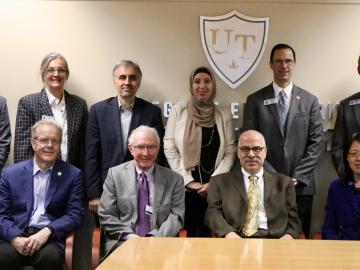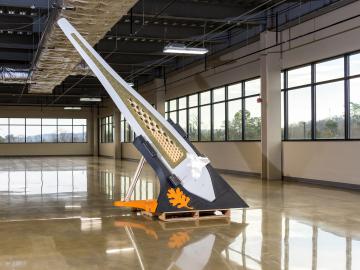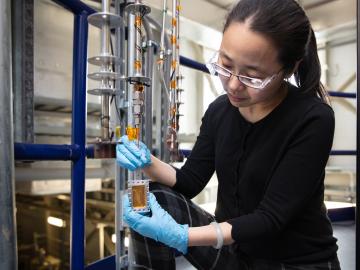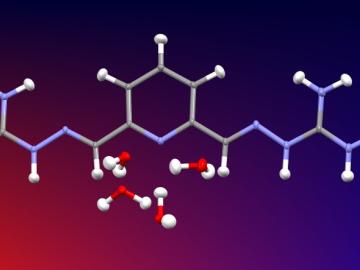
Filter News
Area of Research
- (-) Fusion Energy (3)
- (-) Materials (65)
- Advanced Manufacturing (24)
- Biological Systems (2)
- Biology and Environment (138)
- Biology and Soft Matter (1)
- Building Technologies (3)
- Computational Biology (2)
- Computational Engineering (3)
- Computer Science (15)
- Electricity and Smart Grid (1)
- Energy Science (192)
- Energy Sciences (1)
- Functional Materials for Energy (1)
- Fusion and Fission (8)
- Isotopes (2)
- Materials for Computing (14)
- Mathematics (1)
- National Security (28)
- Neutron Science (32)
- Nuclear Science and Technology (8)
- Quantum information Science (7)
- Supercomputing (127)
News Topics
- (-) 3-D Printing/Advanced Manufacturing (23)
- (-) Bioenergy (11)
- (-) Composites (9)
- (-) Computer Science (19)
- (-) Environment (15)
- (-) Summit (3)
- Advanced Reactors (10)
- Artificial Intelligence (9)
- Big Data (2)
- Biology (4)
- Biomedical (7)
- Buildings (5)
- Chemical Sciences (32)
- Clean Water (3)
- Coronavirus (4)
- Critical Materials (13)
- Cybersecurity (4)
- Energy Storage (34)
- Exascale Computing (2)
- Frontier (4)
- Fusion (18)
- Grid (5)
- High-Performance Computing (4)
- Irradiation (1)
- Isotopes (13)
- ITER (1)
- Machine Learning (5)
- Materials (73)
- Materials Science (78)
- Mathematics (1)
- Microscopy (27)
- Molten Salt (3)
- Nanotechnology (39)
- National Security (3)
- Neutron Science (33)
- Nuclear Energy (23)
- Partnerships (11)
- Physics (28)
- Polymers (17)
- Quantum Computing (3)
- Quantum Science (11)
- Security (2)
- Simulation (1)
- Space Exploration (2)
- Transportation (14)
Media Contacts

ORNL and The University of Toledo have entered into a memorandum of understanding for collaborative research.

Quanex Building Products has signed a non-exclusive agreement to license a method to produce insulating material from ORNL. The low-cost material can be used as an additive to increase thermal insulation performance and improve energy efficiency when applied to a variety of building products.

A modern, healthy transportation system is vital to the nation’s economic security and the American standard of living. The U.S. Department of Energy’s Oak Ridge National Laboratory (ORNL) is engaged in a broad portfolio of scientific research for improved mobility

Using additive manufacturing, scientists experimenting with tungsten at Oak Ridge National Laboratory hope to unlock new potential of the high-performance heat-transferring material used to protect components from the plasma inside a fusion reactor. Fusion requires hydrogen isotopes to reach millions of degrees.

A new method developed at Oak Ridge National Laboratory improves the energy efficiency of a desalination process known as solar-thermal evaporation.

In the shifting landscape of global manufacturing, American ingenuity is once again giving U.S companies an edge with radical productivity improvements as a result of advanced materials and robotic systems developed at the Department of Energy’s Manufacturing Demonstration Facility (MDF) at Oak Ridge National Laboratory.

Researchers at the Department of Energy’s Oak Ridge National Laboratory, Pacific Northwest National Laboratory and Washington State University teamed up to investigate the complex dynamics of low-water liquids that challenge nuclear waste processing at federal cleanup sites.

Ionic conduction involves the movement of ions from one location to another inside a material. The ions travel through point defects, which are irregularities in the otherwise consistent arrangement of atoms known as the crystal lattice. This sometimes sluggish process can limit the performance and efficiency of fuel cells, batteries, and other energy storage technologies.

OAK RIDGE, Tenn., March 1, 2019—ReactWell, LLC, has licensed a novel waste-to-fuel technology from the Department of Energy’s Oak Ridge National Laboratory to improve energy conversion methods for cleaner, more efficient oil and gas, chemical and

Researchers used neutron scattering at Oak Ridge National Laboratory’s Spallation Neutron Source to investigate the effectiveness of a novel crystallization method to capture carbon dioxide directly from the air.


